|
 Small pieces of space debris (usually parts of comets or asteroids) that are
on a collision course with the Earth are called meteoroids.
When meteoroids enter the Earth's atmosphere they are called meteors.
Most meteors burn up in the atmosphere, but if they survive the frictional heating
and strike the surface of the Earth they are called meteorites.
Small pieces of space debris (usually parts of comets or asteroids) that are
on a collision course with the Earth are called meteoroids.
When meteoroids enter the Earth's atmosphere they are called meteors.
Most meteors burn up in the atmosphere, but if they survive the frictional heating
and strike the surface of the Earth they are called meteorites.
The Earth has been struck by many meteorites, some quite large. The adjacent
image shows the Barringer Crater in Arizona
(Ref).
It is 1.2 kilometers across and 200 meters deep, and was formed about 49,000
years ago by the impact of a 50 meter nickel/iron meteorite travelling at a
speed of 11 kilometers per second.
Most meteorites are much smaller and do much less damage, but as we shall
see, in the geologically not so distant past the Earth has probably been struck
by even larger meteorites than the one that formed the Barringer Crater. We have
already discussed the
Tunguska Event
(which may have been a comet rather than an asteroid), and we shall
discuss the high probability that the
extinction of the dinosaurs
was triggered by the impact of a massive meteorite in the
Southern Caribbean region.
Meteors and Meteor Showers
Interplanetary space is littered with rocks tens of meters in diameter or less.
When these meteoroids strike the Earth's
atmosphere at high relative speeds they leave visible trails created when the intense heat caused by
friction vaporizes them. These are called meteors ("shooting stars").
Fireballs
Most meteors are tiny specks of dust and rapidly burn up in the atmosphere. Some
are larger and produce spectacular fireballs that are very bright, and
may explode (in some cases with sound heard on the ground). Meteors are
common; you can usually observe a few per hour on any clear night, but
fireballs are rare. The following three images show some recently observed fireballs.

Hannover, 1995 |
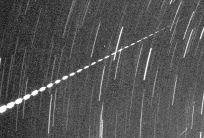
Perseid Shower, 1996 |

Peekskill, 1992 |
The left image shows the path of a fireball recorded over Hannover, Germany. The fireball outshines
Sirius and the constellation Orion
(Ref).
The middle image shows a fireball recorded in the 1996 Perseid meteor shower by the
Dutch Meteor Society.
The curved streaks are star tracks in the timed exposure.
The pulsed nature of the fireball track is produced by the camera which is being chopped.
The right image shows a fireball observed for over 20 seconds from Kentucky to New York in 1992
that led to a meteorite fall in Peekskill, New York. In this image the
fireball is beginning to break up into smaller pieces. Here is a movie of the
Peekskill fireball (972 kB;
Source).
Meteor Showers
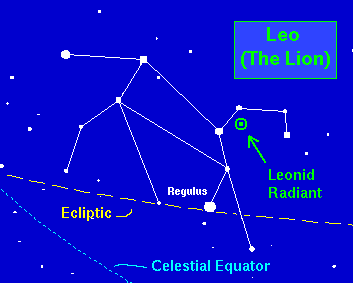 Meteors enter our atmosphere on a regular basis. On a normal night
you can typically see a few sporadic meteors per hour. However, at certain times the rate of
observable meteors is much higher. These periods are called meteor showers.
Further, during meteor showers (which usually last a few days), the majority of
the meteors appear to come from a particular point in the sky, called the radiant of the shower.
The adjacent figure illustrates the position of
the radiant for the Leonid Meteor Shower, and here is a time-exposed image showing clearly the
radiant location
for the 1995 Lyrid Shower.
Meteors enter our atmosphere on a regular basis. On a normal night
you can typically see a few sporadic meteors per hour. However, at certain times the rate of
observable meteors is much higher. These periods are called meteor showers.
Further, during meteor showers (which usually last a few days), the majority of
the meteors appear to come from a particular point in the sky, called the radiant of the shower.
The adjacent figure illustrates the position of
the radiant for the Leonid Meteor Shower, and here is a time-exposed image showing clearly the
radiant location
for the 1995 Lyrid Shower.
The meteor shower is commonly named after the
constellation in which this radiant is found, and occurs annually during a
well-defined time period. For example, the Perseid meteor shower occurs every
year from about July 25th through August 18th, with a peak on August 12, and has
its radiant in the constellation Perseus. In this shower, the typical maximum
number of meteors that can be seen per hour at its peak
is about 70, which is 10 times the rate of sporadic meteors.
Here is an
observational determination of the radiant for the Quadrantid shower, and an
MPEG movie
(127 kB, compressed in time) showing 18 meteors of the
Quandrantid shower. The movie was obtained from
this paper,
where a more detailed and technical discussion of photographing meteors and meteor showers may be found.
Meteor Showers and Comets
The annual nature of meteor showers suggests that they are associated with the
Earth encountering an unusually large number of meteoroids on particular parts
of its orbit. As the following figures illustrate, meteor showers result when
the Earth passes through the orbit of periodic comets.

Meteor showers result when the Earth encounters cometary orbits |
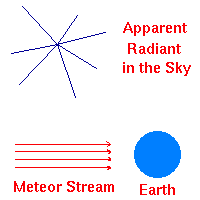
Perspective makes the meteors appear to come from a point in the sky |
As comets move about their orbits they leave a stream of debris because dust
and rocky material is liberated from the head as the ices vaporize. If the earth
crosses the cometary orbit, this debris leads to an increased number of meteors (left figure).
These periods are called meteor showers.
That meteors in meteor showers appear to radiate from a single point in the sky
is an optical illusion, as illustrated in the figure on the right.
The meteor stream that produces the shower has meteoroids moving on
essentially parallel trajectories, but because of perspective (parallel lines
appear to meet at infinity) the meteors actually entering Earth's atmosphere on
parallel trajectories seem to radiate from a point, as viewed from a site on Earth.
Some Meteor Showers
We list a few of the stronger meteor showers. Since the orbits of comets are
very well known, in most cases it is possible to list the comet whose orbital
debris is responsible for the shower.
| Some Meteor Showers |
| Name |
Date of
Maximum |
Meteors / Hour
at Max |
Parent |
| Quadrantids |
Jan. 4 |
110 |
- |
| Perseids |
Aug. 12 |
68 |
Comet 1862 III |
| Orionids |
Oct. 21 |
30 |
Comet Halley |
| Leonids |
Nov. 17 |
10 |
Comet P/Tempel-Tuttle |
| Geminids |
Dec. 14 |
58 |
3200 Phaethon |
Here is a more extensive
listing
of meteor showers and their characteristics.
Are the Leonids Coming?
Meteor showers often vary in intensity from year to year, presumably reflecting
details of encountering the orbit of the parent comet. One shower that
normally is rather weak, but can at times be strong is the Leonids. As the
preceding table indicates, on the average it only gives 10 meteors per
hour---not even twice the sporadic rate. However, there is a prediction that
the Leonids will grow stronger for the next two years and in 1998 (or perhaps
1999) will produce 10,000 or more per hour at the peak (when the parent comet is near
perihelion). According to some estimates the
rate will be as high as 40 meteors per second (!) for a short period; a
veritable meteor storm.
Such predictions often do not pan out, but there is historical precedent for
spectacular outbursts from the Leonids. On November 12-13, 1833,
a "tempest of falling stars" was observed in Boston with a rate
"half that of flakes of snow in an average snowstorm", while in the 1966 the Leonids produced
"a hail of meteors too numerous to count" according to one observer and 150,000
per hour for a 20 minute period according to another
(Reference). Newspaper accounts of the time reported that many people were
awakened from sleep either by the shouts of neighbors, or the light of the
meteors in the sky.
The image on the right depicts a wood-cut engraving by
Adolf Vollmy based upon an original painting by the Swiss artist Karl Jauslin,
that is in turn based on a first-person account of the 1833 storm by a
minister, Joseph Harvey Waggoner. According to Waggoner's account,
"... it is not possible to give in a picture
a representation of the stars falling at all points of the compass at once. But
they fell in myriad's to the north,
east, south and west. Any representation on paper must at best be a very
limited idea of the reality"
(Reference). Here is another artist's depiction of the
view from Niagara Falls during the 1833 shower, and
another account of the history of the Leonids.
You are encouraged to follow these predictions of Leonid intensity as
November, 1998, approaches. If they are true, it will be a
spectacular sight---perhaps the greatest meteor display of the last 100 years.
To help you keep track, here is
the Leonid '98 Meteor Outburst
Mission HomePage, a set of
predictions for 1998 Leonid rates, and a
history of
Leonid showers. For good measure, here is the orbit and
present position
of the parent comet,
P/Tempel-Tuttle.
The Birth of Modern Meteor Studies
As an historical note, the 1833 Leonid shower in a certain sense marked the
birth of the modern study of meteors, because attempts to explain the
remarkable outburst eventually produced
the realization that the Leonids are
correlated with the periodic comet P/Tempel-Tuttle. This led to a general
understanding of meteor showers as
resulting from the Earth encountering the orbit of a periodic comet.
These studies indicate that P/Tempel-Tuttle is in an unusual orbit for a comet, because it
(1) comes close to the Earth's orbit, but
(2) has a period
sufficiently long that its orbit is only slightly perturbed by the planets.
Comets with short periods that come close to the Earth typically do so only a
time or two before gravitational interactions with the planets (primarily
Jupiter) disturb them into other orbits.
But P/Tempel-Tuttle's orbit has been relatively stable for many centuries
and meteor storms have been seen for more than 1000 years that we now know are associated
with this comet.
Classification of Meteorites
Several hundred tons of meteoroids enter the Earth's atmosphere each day. Most
of these are very small pieces (milligrams) that burn up quickly in the
atmosphere and never reach the surface. The following image shows a trail of a
meteoroid captured in aerogel exposed to space by the
EURECA spacecraft of the
European Space Agency.
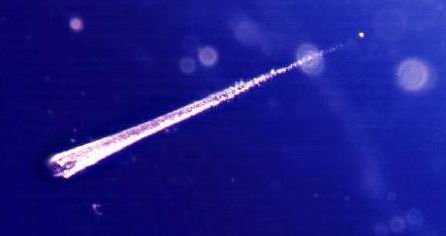 |
|
A micrometeoriod captured in aerogel |
The track of the meteoroid in this image is only about 0.05 inches long. The
meteoroid itself has a diameter of only about 1/1000 of an inch and has come
to rest just beyond the narrow end of the track in the upper right (the small white dot).
Some of the larger and sturdier meteoroids survive the frictional heating and strike the Earth's surface; these
we call meteorites. Most meteoritic material originates from
pieces of asteroids; a smaller amount comes from comets. Thus, meteorites are
important scientifically because they tell us about these
primordial objects that we believe to be similar in composition to the material from which the Solar System formed.
Types of Meteorites
Here is a nice
classification and introduction
to meteorites, and here is a good
introduction to meteorites by the Meteorite and
Impacts
Advisory
Committee
to the Canadian Space
Agency.
The following images show examples of three
important classes of meteorites: a
chondrite
(Ref), an iron meteorite
(Ref), and a
carbonaceous chondrite
(Ref).

Chondrite (Stony) Meteorite |
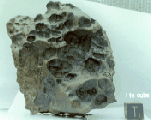
Iron Meteorite |
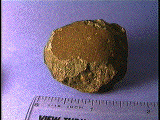
Carbonaceous Chondrite |
The stony meteorites (chondrites) are the most common, iron meteorites are
composed largely of iron and nickel, and carbonaceous chondrites are of
particular interest because they contain organic compounds and therefore may
hold keys to how life developed in the Solar System.
Antarctic Meteorites
Meteorites that are discovered by accident are called "finds"; those discovered because
someone has seen a meteorite fall are called "falls"
(well, sometimes even scientific nomenclature is simple and logical!).
Although meteorites have been found in many places, the richest hunting ground for meteorite finds is
the Antarctic ice sheet. This is not because more meteorites fall in
Antartica, but because they are easier to find and identify there.
There are two primary reasons:
- Because there are few other sources of rocky material on the Antarctic ice
sheet, rocks found there are likely to be meteorites. This is in contrast to
other areas where meteorites are mixed in with much larger numbers of
normal rocks and may be difficult to identify as extraterrestrial.
- In certain places, the movement of the ice sheet tends to concentrate
its accumulated load of meteorites at the surface.
It is said that in some places one can walk across the ice sheet and almost always be in
site of a rock, and be certain that the rock is a meteorite. Here is a more
extensive discussion of
Antarctic meteorites.
A Meteorite from Mars with Evidence for Life?
 In some cases we believe that we have strong evidence for the exact source of
particular meteorites because their detailed composition is too similar to the
known composition of a parent body to be a coincidence.
Most meteorites come from asteroids and comets, but
there are a few that are thought to have originated on the Moon, and
a few others that are thought to have come from Mars.
In some cases we believe that we have strong evidence for the exact source of
particular meteorites because their detailed composition is too similar to the
known composition of a parent body to be a coincidence.
Most meteorites come from asteroids and comets, but
there are a few that are thought to have originated on the Moon, and
a few others that are thought to have come from Mars.
Although this may seem surprising at first, it is not so much so when you consider the violent impacts
that all objects in the Solar System have sufferered in the past. It is quite
plausible that such impacts could have knocked parts of the Moon and Mars into
orbits that would eventually insersect that of the Earth.
The above left figure
(Ref)
is of a 4.5 billion-year-old rock
(meteorite ALH84001), that was discovered in
Antartica and that is believed to have
been dislodged from Mars by an impact about 16
million years ago and that fell to Earth 13,000
years ago.
This meteorite is the center of a major controversy at present because it has
been claimed (and disputed) that it contains fossil
evidence that may indicate that primitive life existed on Mars more
than 3.6 billion years ago
(more info).
If true, this would be a major scientific discovery, but the jury
is still out at the moment.
A Piece of the Asteroid Vesta?
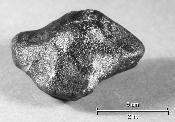 The meteorite shown on the right
(Ref)
was discovered in Western Australia in 1960.
It is unique because it is made almost entirely of the
mineral pyroxene, and its detailed composition and structure are different from
any rock known for the Earth or the Moon.
This composition suggests strongly that the origin of this meteorite is
the 325-mile diameter asteroid Vesta,
which has the same unique spectral signature for pyroxene.
The meteorite shown on the right
(Ref)
was discovered in Western Australia in 1960.
It is unique because it is made almost entirely of the
mineral pyroxene, and its detailed composition and structure are different from
any rock known for the Earth or the Moon.
This composition suggests strongly that the origin of this meteorite is
the 325-mile diameter asteroid Vesta,
which has the same unique spectral signature for pyroxene.
Other small asteroids observed near Vesta have the same pyroxene signature and are
believed to be chips blasted of the surface of Vesta by collisions.
This debris extends all the way to a Kirkwood gap
that is swept free of asteroids by resonances with Jupiter's orbit.
This resonance interaction removes material from the main asteroid belt and hurls it onto a new orbit
that can cross Earth's orbit.
It is speculated that this meteorite was torn off Vesta's surface as part of a larger fragment
that broke apart in subsequent collisions, ended up in a Kirkwood gap, and was
ejected by Jupiter's gravity onto a collision course toward Earth.
Hubble Space Telescope observations reveal a giant impact basin on Vesta
that may be evidence for the original collision that produced the meteorite
(more info).
Meteorite Impacts
 The Barringer Crater shown in the adjacent image
(Ref) is only the best-preserved of large
meteor impacts. There is evidence for many more. Here is a link to some views of
terrestrial impact craters,
and here is a
clickable map
of terrestrial impact structure locations. Although in many instances these
impact structures have been partially obliterated by erosion and tectonics,
there is rather strong evidence that most are fossil impact craters.
The Barringer Crater shown in the adjacent image
(Ref) is only the best-preserved of large
meteor impacts. There is evidence for many more. Here is a link to some views of
terrestrial impact craters,
and here is a
clickable map
of terrestrial impact structure locations. Although in many instances these
impact structures have been partially obliterated by erosion and tectonics,
there is rather strong evidence that most are fossil impact craters.
Meteorite Impact Velocities
The average velocity of meteoroids entering our atmosphere is 10-70 km/second.
The smaller ones that survive the trip to the Earth's surface are quickly
slowed by atmospheric friction to speeds of a few hundred kilometers per hour,
and so hit the Earth with no more speed than if they had been dropped from a
tall building. For meteorites larger than a few hundred tons (which
fortunately are quite rare), atmospheric friction has little effect on the
velocity and they hit the Earth with the enormous speeds characteristic of
their entry into our atmosphere. Thus, for example, it is estimated that the
meteorite that produced the Barringer Crater was still travelling at
11 km/second when it struck what is now the Arizona desert 49,000 years ago.
Such objects do enormous damage, because the kinetic energy carried by the
meteorite is the product of the mass and the square of the velocity.
There is
no documented record of a human being killed by a meteorite, but in recent
years meteorites have crashed into bedrooms in Alabama, dining rooms in Connecticut, and a car
in New York
(more info).
The Peekskill Meteorite and other Fireballs
On October 9, 1992, a fireball was seen streaking across the sky
from Kentucky to New York. At least 14 people captured part of the fireball on
videotape; here is a spectacular
MPEG movie (1 MB MPEG) of the fireball
(source).
A 12-kilogram stony meteorite (chondrite) from
the fireball fell in Peekskill, New York, smashed the trunk of a parked
automobile, and came to rest beneath it.
These are the first motion picture recordings of a fireball with an associated
meteorite fall.
Here is a short MPEG movie of a -4 magnitude
Delta Capricornid fireball (253 kB MPEG)
recorded near Hannover, Germany, on January 5, 1995.
The K-T Event and the Extinction of the Dinosaurs
Sixty-five million years ago, about 70 percent of all species
then living on Earth disappeared within a very short period in what is
termed the Cretaceous-Tertiary Mass Extinction---commonly known as
the K-T Event (K is used to denote the Cretaceous period rather than C to avoid confusion with
other periods such as the Cambrian). Among the
species that disappeared were the last of the dinosaurs. The cause of this
and other sudden species extinctions has long been an important and controversial topic.
In 1980, physicist Luis Alvarez and coworkers reported finding a very high concentration of the element
iridium in the sedimentary clay layer laid down at the time of the K-T extinction.
On Earth, iridium is very rare in the crust becausem it was concentrated in Earth's core
when it was largely molten.
However, chondritic meteorites often still have the primordial solar system abundances of these
elements. This led Alvarez et al to suggest that a chondritic asteroid 10 kilometers in diameter that struck the Earth
in the K-T period would contain enough iridium to account for the worldwide clay layer iridium
enhancement, and that this meteor impact could also have triggered dramatic climatic changes
that produced the K-T extinction.
The Crater Associated with the K-T Extinction?
Since the original proposal, additional evidence has
accumulated that strongly supports the impact theory.
However, the theory remains contentious, and opponents
had long argued that there was no evidence for the
requisite crater associated with the impact.
In 1990, it was realized that geophysical data taken 10 years earlier
in a search for oil in the Yucatan region of Mexico indicated
a 180-kilometer diameter ring structure centered on the present coastline and
lying beneath several hundred meters of sedimentary deposits called
Chicxulub that had the requisite characteristics.
The Chicxulub structure has been age dated at 65 million years, and additional studies
support its interpretation as a relic impact crater (here is a
summary; here is a natural history museum
exhibit
concerning the event and recent ocean core sampling providing support for the
K-T hypothesis). Although the original crater has been
eroded and covered with sediment, models suggest that shortly after formation
the Chicxulub crater may have resembled the crater
Strindberg on Mercury.
Summary: The Asteroid and the Dinosaur
Thus, it has been proposed that 65 million years ago in what is now Yucatan
the impact at a velocity of 11 km/second of a 10-kilometer wide asteroid
threw huge amounts of matter into the atmosphere (in addition to local
phenomena like generating 2000 foot waves that may have emptied the Gulf of
Mexico!). This created months of darkness (interfering with photosynthesis) and much
cooler temperatures globally, and the resulting harsh conditions led to
the extinction of many species, including the last of the dinosaurs.
Although this is a compelling hypothesis with substantial support, it remains controversial and has broad but not
yet uniform acceptance within the scientific community.
It is estimated that impacts of asteroids as large as the one thought responsible for the K-T extinction
occur about once every hundred million years
(more info).
| 

